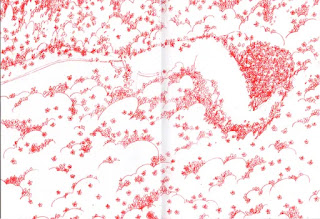Kit Anderson's Avery Hill collection of her short stories, Safer Places, is a big, warm hug of a book. Sure, it's barbed, haunted, and even desperate at times, with some characters who are yearning for comfort that never comes. But it's also resolutely compassionate toward all of their dreams, with unusual links between seemingly unrelated stories that build a tapestry of empathy or a house full of the titular safer (not always safe, but safer) places.
I've reviewed many of the stories in this collection in their original minicomic or short story form, so I'm mostly going to comment on the sequencing and the way the themes were built. There are two different interstitial features in the book, both of which are fantasy-related in their own way. The first is "Quest," a series of anecdotes about a tiny wizard and the shopkeeps who wonder what he does all day. One sneers at this small being doing anything useful with mushrooms and twine, while the other is resolutely certain that the wizard is more capable and powerful than he looks. The wizard is a Radagast-type figure, taking care of nature and helping things grow and heal in the face of war and disaster. Quest appears as the comic the sole protagonist is reading in "The World's Biggest Ball of Twine," which happens to be about a desperately lonely man who is clinging to the memory of a tourist trap trip he spent with a loved one, connecting moments to memories like snapshots.
The other track of interstitials is the "Sleep Tape" grouping. Each of them is a two-track comic with a narrative that's a classic meditative (and functionally soporific). Each story has a different tone and function for these tapes. "Country Lane" is a story about someone who's unable to fully commit to a relationship, but the gentle tape somehow gently taps into their subconscious to lead them inevitably to the warmth of connection. "Forest Walk" is a futuristic story that grounds an isolated character through their day, substituting the cold efficiency of their routine with the pleasant ambling of a walk in the woods. "At The Seaside" repeats this idea, this time with a man trapped in rigid, cold routine being allowed to expand his consciousness into the night sky.
There are other stories that explore variations on this theme. "The Basement" uses dream logic and a cat guide in order to have a boy work out grief and the anxiety of living in a transitional period. "Deep Breath" offers a brief glimpse of an underwater world. "Lookout Station" is about a lone scout at a station on another world whose sentient computer tries to guide it in a guided meditation but is resisted by the desperate pull of potential connection. "Wallpaper" similarly uses computer backgrounds in an attempt to enter this meditative state that promises freedom, escape, and safety. "Ride" uses a bike ride to escape an undesired move. "Wonders Of The Lost City" goes in the opposite direction, as the fantastical goal of a quest is too much to absorb, and the characters hastily retreat back to their mundane life.
"Weeds" is the centerpiece of the collection, about a college student who contracts a disease that causes her to sprout flowers from her body. The disease will eventually cause her to turn fully into a plant, so much of the story revolves around where she wants to end up. There's a sweet friend who offers her a place on her table, her overbearing mom wants her in her backyard, and the student is just trying to finish her poetry dissertation. Ultimately, she chooses to lie down in a park, but the transformation is not quite what she expects, as she transitions to a new, unknown phase of her life. Anderson works in a wide variety of visual styles here: sumptuous color for the wizard stories & "Wonders", colored pencil for "Weeds", spot color, color washes, and black & white. It all goes to the same conclusion: nothing ever stands still, no matter how much we might want it to. We either move on or we risk being trapped.









No comments:
Post a Comment